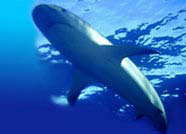|
A major problem with assessing the status of the world's shark
populations is finding them. Many sharks species are rarely seen. The
IUCN Red List lists numerous sharks that can't yet be categorised because
we simply don't know enough about them.
- The Ganges shark (glyphis gangeticus) is found in the Ganges river
area in estuarine and inshore waters. Our sum knowledge of them has
been derived from three ancient museum specimens. This species is
critically endangered. It should not be confused with the bull shark
(Carcharhinus leucas) which is also sometimes called the Ganges shark.
- The Borneo shark is classified as endangered. Once again, it is
found inshore and in coastal areas and has not been widely studied.
It is threatened by a rise in shark fisheries in the region.
- Other shark species listed as endangered include the rare speartooth
shark that is at risk from increased coastal development in the Indo-Pacific
region which is rapidly destroying its coastal and river habitat.
The whitefin tope shark is also struggling for survival in the overfished
waters around the Philippines. Its range is extremely restricted and
there is no recent information.
- You might think that a good strategy for sharks would be to head
for the depths, but you'd be wrong. The smoothback angel shark is
a bottom-dwelling species found off Brazil in the waters of the western
South Atlantic shelf. Here the species is being depleted by bottom-trawl
fisheries. The problem is made worse by the fact that the smoothback
angel shark is particularly slow to mature - young sharks are caught
before they have a chance to breed.
- Many more sharks' species that are not yet endangered could be soon
if current trends continue. A number of 'lower risk' classifications
are considered to be 'near threatened' or 'conservation dependent'.
Similarly, many species classified as 'vulnerable' are more at risk
in some areas than the category would imply. Here are just a few of
them.
- The great white Shark
The film Jaws brought the great white star status but also fuelled
demand for great white shark products, strange though it may seem
to use an animal's dental work as an ornament. Peter Benchley, the
author of the book, has been prominent in the campaign to stop the
practice of shark finning but conservationists are still concerned
that the film perpetuates the idea that the only good shark is a dead
one.
- Great whites mature late and have few young and they are caught
as bycatch as well as being deliberately targeted.
- Studies have shown that great whites are declining, both in number
and size. They are protected in some areas, but even if they are,
the conservation measures are not always enforced with much vigor.
- Basking Shark
The basking shark is the second largest fish in the world. It is often
seen in British coastal waters. Certain sub-populations, especially
those in the North Pacific and Northeast Atlantic, have been seriously
overfished in recent years. The basking shark has a particularly large
dorsal fin, which may be its downfall at a time when the demand for
shark fin soup is increasing.
- Basking shark numbers have been falling rapidly because of over-exploitation
in some areas. There are real concerns that populations will never
recover because the fish mature so slowly and have such a low reproductive
rate.
- In November 2002, basking sharks were added to Appendix II of the
Convention on International Trade in Endangered Species (CITES). This
means that basking shark products can only be sold with special permits.
They've been protected in waters within 20 km of the British coast
for some time.
- Whale Sharks
Whale sharks are gentle giants and are particularly vulnerable because
they move slowly and close to the surface. Like their name-sakes,
they are targeted by harpoon fisheries because their meat and fins
fetch a high price on the international market. Even back in 1999,
a single whale shark fin was on sale in Beijing for £11,000.
- Paradoxically, whale sharks could play an important role in eco-tourism
because they are no threat to humans and are safe to swim with. There
is a growing interest in them among the dive community. In November
2002, whale sharks were added to Appendix II of the Convention on
International Trade in Endangered Species (CITES). This means that
whale shark products can only be sold with special permits.
- The Sand Tiger Shark
The sand tiger inhabits coastal waters and lives in isolated populations
that don't mix. They are now threatened by fishing activity, including
spear fishing and beach meshing.
- Populations in Australia and South Africa have been studied and
are showing a marked decline. Sand tigers are protected in Australia
but even there, there is little sign of recovery.
Top 
|
|
|
|







